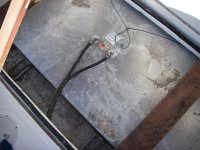On my 25 cruiser there is some water in the hull, below the sole, that you can see when the two round access plates in the side steps are removed.
All the interior hatches are dry and the bilge is dry, but this water is trapped and can't flow to the bilge.
How does it get there? The boat sat in the rain at the dealer for a number of months, but the sole seems to be well sealed.
Any thoughts appreciated.
[url=https://ibb.co/cFQrDk][img]https://preview.ibb.co/kixhKQ/0926171302.jpg[/img][/url]
[url=https://ibb.co/jQCtR5][img]https://preview.ibb.co/mynSm5/0926171303a.jpg[/img][/url]
All the interior hatches are dry and the bilge is dry, but this water is trapped and can't flow to the bilge.
How does it get there? The boat sat in the rain at the dealer for a number of months, but the sole seems to be well sealed.
Any thoughts appreciated.
[url=https://ibb.co/cFQrDk][img]https://preview.ibb.co/kixhKQ/0926171302.jpg[/img][/url]
[url=https://ibb.co/jQCtR5][img]https://preview.ibb.co/mynSm5/0926171303a.jpg[/img][/url]

